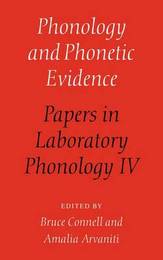
|
Phonology and Phonetic Evidence: Papers in Laboratory Phonology IV
Hardback
Main Details
| Title |
Phonology and Phonetic Evidence: Papers in Laboratory Phonology IV
|
| Authors and Contributors |
Edited by Bruce Connell
|
|
Edited by Amalia Arvaniti
|
| Series | Papers in Laboratory Phonology |
|---|
| Physical Properties |
| Format:Hardback | | Pages:418 | | Dimensions(mm): Height 235,Width 157 |
|
| Category/Genre | Phonetics and phonology |
|---|
| ISBN/Barcode |
9780521482592
|
| Classifications | Dewey:414 |
|---|
| Audience | | Professional & Vocational | |
|---|
|
Publishing Details |
| Publisher |
Cambridge University Press
|
| Imprint |
Cambridge University Press
|
| Publication Date |
14 September 1995 |
| Publication Country |
United Kingdom
|
Description
The work published in Phonology and Phonetic Evidence presents an integrated phonetics-phonology approach in what has now become an established field, laboratory phonology. The volume is divided into three sections. Part I deals with the status and role of features in phonological representations; Part II, on prosody, contains, amongst others, two papers which present for the first time detailed acoustic and perceptual evidence on the rhythm rule; and Part III, on articulatory organisation, includes several papers which from different perspectives test hypotheses derived from articulatory phonology, thereby testifying to the great influence this theory has exerted in recent years. This, the fourth in the series of Papers in Laboratory Phonology, will be welcomed by all those interested in phonetics, phonology and their interface.
Reviews"LabPhon4, like the other volumes in the series, is an important document of the development of this research strategy." Phonology "The book makes it clear that the effective development of the sound systems needs to unify phonetics and phonology into a more empirically oriented discipline." Stanislaw Puppel, Ph.D., The Phonetician "LP allows methodology in related sciences; including acoustics, psychology, information science and life sciences, and is becomming a powerful tool in shaping our knowledge of the structure of sound systems." Joyce McDonough, Phonology
|